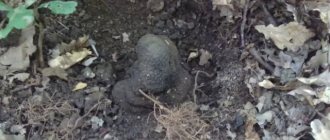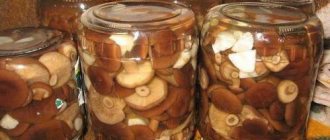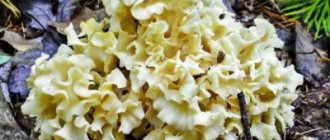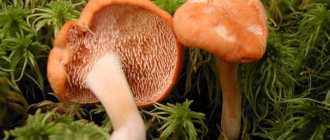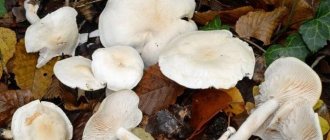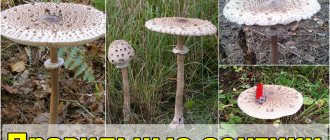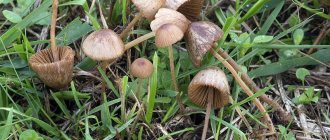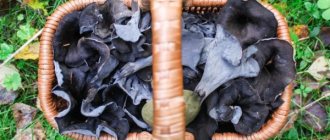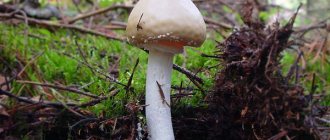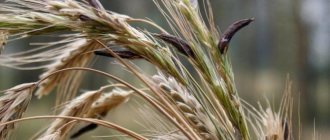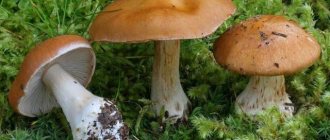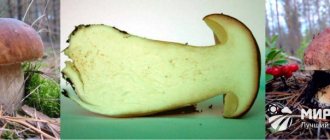Hypomyces lactiferous is a mold that grows on the fruiting bodies of other varieties. Latin name: Hypomyces lactifluorum. In common parlance it is called the lobster mushroom.
Short description
| Type of mushrooms: | edible |
| Other names (synonyms): | Lobster mushroom |
| Latin name: | Hypomyces lactifluorum |
| Family: | Hypocreaceae |
| Distinctive feature: | Contrary to its common name, it is not a fungus, but rather a parasitic ascomycete that grows on certain types of mushrooms, covering them in a reddish-orange color that resembles the outer shell of a boiled lobster. |
| Beginning of the season: | September |
| End of season: | november |
| Smell: | shellfish |
| Taste: | soft |
| Tasting score: | [kkstarratings] Have you tried this mushroom? Then rate it! |
| Fruit body: | hard, looks like an orange moldy coating; quickly attacks the owner and soon completely absorbs him; the surface is dotted with tiny pimples. |
| Leg: | – |
| Hymenophore (bottom of cap): | – |
| Disputes: | fusiform, 35-50 x 4-5 microns. |
| Pulp: | – |
| Natural environment and mycorrhiza: | grows on the fruiting bodies of other mushrooms. |
| False doubles: | – |
| Growing: | – |
| Use: | quite suitable. |
| Medicinal properties: | – |
| Spreading: | North America. |
The Case of Mutant Mushrooms
Episode 1.
Hot and wet July, collecting spruce saffron milk caps. The prickly wet paws are just waiting for a person to bend over for a mushroom and pour half a bucket of cool water on his collar. A gust of wind - and it feels like the spruce is shaking itself off, like a dog that has taken a bath... And it’s all over my collar. But it was worth it - a family of “deaf” saffron milk caps grew up in a small clearing. From a distance you can see they are massive, twisted, pleasantly ugly. The locals neglect them, but I look for them specifically: tasty, not wormy at all, even in the middle of summer...
Our Russian hypomyces on spruce camelina (photo by I. Lebedinsky)
Episode 2.
Same time, same heat and dampness. In the broad-leaved forest, where the darkness from the closed crowns does not allow a blade of grass to fall on the black loose soil, white figures of moss mushrooms are lined up. It feels like the mushrooms have turned into moldy statues, frozen in space and time. They fled from the mushroom Sodom, but could not stand it, cast a farewell glance at the kingdom of forbidden pleasures, and froze forever... Around one generation of moss mushrooms replaces another, and these stand and stand. I won't bother them...
The moss fly, which became immortal from hypomyces (photo by Olga Gubanova)
Episode 3 (reconstruction by the author).
Canada, Ontario. Broad-leaved forest. Hot, damp. Cheerful, mustachioed fat men in baseball caps (this is how I imagine American mushroom pickers, sorry) are excitedly collecting some grotesque mushroom-shaped objects of an unexpected red color, like boiled crayfish. At first glance, it may seem like this is some kind of game: the presenter has placed brightly colored dummies of mushrooms in the bushes, and the participants collect them at speed, but this does not smell like a game. But yes, it smells like boiled lobster...
But these are overseas lobsters (photo from open sources)
What do these three episodes have in common? They are united by the main participant in the events: a moldy fungus from the genus Hypomyces (hypomyces). Each time he is, of course, different. American russulas and milkweeds are transformed into a delicious “lobster” by Hypomyces lactifluorum. Tubular mushrooms, especially flywheels, are eaten on the vine, usually by Hypomyces chrysospermus. Unlike the first, he does not turn his victims into delicacies at all - on the contrary, tubular mushrooms overgrown with moss up to their ears are considered mildly poisonous. Finally, the third (as well as the fourth, fifth and tenth) type of hypomyces affects our saffron caps and saffron mushrooms, enveloping their plates and protecting them from the ubiquitous fungal flies... They write that the brick-red hypomyces (Hypomyces lateritius) took responsibility for this matter. but he’s hardly the only one involved here. Most likely, there are accomplices.
Diseases and enemies of garden mushrooms
Those mushrooms that people have been growing for many decades and even centuries suffer the most from diseases and pests.
Weed mushrooms don't care at all. By increasing the yield of a cultivated mushroom, the mushroom grower places it in greenhouse conditions and, against its will, makes it more helpless and vulnerable.
With each new crop rotation, the enemies of champignons and oyster mushrooms adapt better to chemicals and learn to withstand the most sophisticated methods of protection.
Sometimes they can destroy the entire harvest and lead to the ruin of even a large mushroom growing company.
However, forest mushrooms also suffer from pests. Russulas, green boletuses, saffron milk caps, purple moths, white-legged boletuses and slender pigweeds get the most. Occasionally, even porcini and boletus mushrooms become victims of attack.
Actually, molds can attack almost any mushroom. As a rule, this happens during prolonged rains and during a thaw after frost.
Mushroom pickers and mushroom growers should know what enemies they have to deal with, as well as how to save mushroom plantations and how not to get poisoned by spoiled mushrooms.
Mycogonosis, or white wet rot of champignons, is well known to mushroom growers working with champignon crops.
The causative agent of this harmful disease, the microscopic fungus Mycogone perniciosa, is a specialized parasite of the fruiting bodies of champignons.
It is well adapted for life in cultivation premises and in open ground. Mycogonosis can destroy most of the mushroom harvest. Eliminating its outbreak requires a lot of effort and money; prevention is much easier and cheaper.
Usually the primary source of mycogonosis is covering material, especially peat, with spores of the pathogen.
Diseased fruiting bodies appear even before the first mushroom harvest and become secondary sources of infection. To suppress infection in the covering material, it is treated with a fungicide after filling.
Sporgon, bayleton and benomyl are also used. Treatment is carried out no later than 15 days before the first harvest.
Fruiting bodies affected by mycogonosis are secondary sources of infection, because parasite spores ripen in large numbers on their surface. Therefore, diseased mushrooms are disinfected and removed. Since fungicides cannot be used during the fruiting period, commercial salt is most often used for disinfection.
Fruiting bodies affected by mycogonosis can be easily distinguished from healthy ones or those affected by other diseases.
Sick champignons “sit” tightly in the layer of covering material, have an abnormal shape, are often not divided into stem and cap and can grow together in several pieces. They develop much faster than healthy mushrooms.
The disease is irreversible and lasts 4–5 days. At its beginning, the fruiting bodies retain a smooth surface, dense consistency, white flesh, and a pleasant mushroom smell. After 2–3 days, they increase in size, the surface becomes bumpy, covered with short white pubescence, which darkens over time.
At the end of mycogonosis, the mushrooms turn into shapeless formations up to 8-10 cm in size, with a watery consistency and a putrid odor. Dark brown drops of exudate containing parasite spores often appear on their surface.
On the surface of diseased fruiting bodies, many mycogon spores are formed, which serve to spread the parasite. Spores are spread by splashes of irrigation water, hands and tools when picking mushrooms. They can germinate a few hours after ripening and infect healthy fruiting bodies.
Penicillium glaucum is well known to mycologists, botanists, agronomists and culinary specialists.
It was awarded several sonorous names: ink mold, common mold, gray mold and bread mold, green brush mold.
Penicillium often appears on bread, jam, cheese, ink, old shoes and other objects.
It has also been observed on a variety of mushrooms.
We found penicillum on aspen boletuses, boletuses, purple moths and russula.
External symptoms of the disease are a bluish-green velvety coating on the entire fruiting body of the fungus.
The gray and other shades of green color of this mold are produced by its spores, which in mass look like very fine and light dust.
A weak breeze is enough for a whole cloud to rise into the air.
Considering the extreme unpretentiousness of penicillum in food, it is not surprising that it is widespread everywhere.
The fungus persists in the form of spores or mycelium on all kinds of substrates and everywhere.
Representatives of the hypomycete family damage the fruiting bodies of edible mushrooms, including such valuable ones as porcini mushrooms and camelina.
However, insect larvae, especially various flies and fungus gnats, cause much more harm to these mushrooms. Two types of hypomyces - orange and rosette - harm the champignon culture.
Peckiella luteovirens, or green hypomyces (Hypomyces viridis), is one of the most common species of this very famous genus in Russia.
A parasitic fungus develops on some russulas, forming yellow-green stromas (massive plexuses of mycelium) on their plates, covering the entire lower part of the caps. Such plates cannot develop normally and look like flat ribs, and sometimes are completely invisible.
An even more common type of harmful genus hypomyces is Apiocrea chrysosperma, or golden-spore hypomyces (Hypomyces chrysospermus).
It is often found on the fruiting bodies of mushrooms from the boletaceae (tubular mushroom) and pig fungi families.
This parasitic fungus can be found on the green flywheel, slender mushroom, white-legged boletus, much less often on the porcini mushroom, boletus and common oiler from July to October. Porcini mushrooms are more severely affected by this parasite in the south of Russia, on the border with the forest-steppe.
The mycelium of the parasitic fungus penetrates the tissues of the host's fruiting body and fills the tubes. The result is the so-called “deaf mushrooms”. On the mycelium, one type of spore first develops, and then characteristic golden-yellow spores, which fill the entire fruiting body and are released after its destruction.
Mushroom pickers usually observe the second stage of development of apiocrea - golden-spore sepedonium (Seedonium chrysospermum).
The fungus parasitizes tubular mushrooms first in the form of white mold, which then looks like a powdery golden-yellow coating. Apiokraea and Sepedonium, apparently, are perennial species, because they infect fruiting bodies for several years in a row at the bottom and in the same place.
Where does hypomyces lacticiferous grow?
Distributed throughout North America. Found in mixed forests of the USA, Canada, and Mexico. It parasitizes on fungi of the Russula family, which includes different types of Russula and laticifers. Often found on milk mushrooms.
Hypomyces lactiferous usually appears after heavy rains and does not bear fruit for long. After the parasite settles, the “host” stops its development and spores stop forming.
It is found only in the wild in association with other species on which it can parasitize. It is not removed artificially. Fruits from mid or late July to September.
It is very popular in places where it is common. In the USA, lobster mushrooms are sold dried. They can be purchased at farmers markets and some grocery stores. Their price exceeds the cost of dried whites. They are exported to European and Asian countries, especially Japan and China, where they are considered an exotic product.
Time and place of fruiting
Lobster mushrooms are distributed mainly in North America - from Mexico in the south to Canada in the north. It is possible to find them after rainy weather. These mushrooms bear fruit for a short period.
Hypomyces lactiferous is a mold species that settles on fruiting bodies. “Lobsters” parasitize on milkweeds and russula, for example, pepper mushrooms.
If hypomyces lactiferous infects the host fungus, the plates of the affected body stop developing and spores do not form in them.
Types of molds and their descriptions with photos
Molds are called micromycetes. They have a microscopic structure, represented by a very thin multi-row body-mycelium. The body is branched, rarely contains septa, and is the base of a multinucleate mycelium. Details of the structure can be seen in the photo.
The characteristic features of Molds are the following:
- The mycelium is the basis of the vegetative body - thread-like branched hyphae.
- Large mycelium size.
- Mycelium, unlike yeast, is divided into cells.
- Possibility of reproduction in three ways: vegetative, asexual, sexual.
There are several classifications of mold. The most commonly used classification is by color (mushrooms are white, yellow, black, green, brown, red) and classification by the number of cells.
Based on the number of cells, mold is divided into 2 types: zygomycetes and ascomycetes. Zygomycetes are a small group of unicellular fungi. Ascomycetes are multicellular.
Mycologists distinguish 4 genera of Molds:
The genus Aspergillus has several hundred species. Its mycelium has partitions characteristic of higher mushrooms. Initially, mold is white in color, but as it matures it acquires a wide variety of shades. Reproduction of Aspergillus species occurs traditionally asexually, but some higher species are capable of sexual reproduction.
Many species of Aspergillus are dangerous to human health. They can cause serious illness in people. Different types are actively used in the food industry and medicine.
Botrytis is popularly called gray mold. Myceliums form dense, colorless colonies, which, due to their density, acquire a gray smoky tint. Representatives of Botrytis are single-celled fungi that settle in the soil and on plant remains.
Hyphae are visible to the naked eye. Species of this genus are very variable, so they can take on a wide variety of forms. Representatives of Botrytis are indispensable in winemaking. They do not pose any particular danger to humans. Botrytis species can be affected by hyperparasitic fungi.
Penicillium is considered a noble mold. It is actively used in traditional medicine, as well as in cheese and sausage production. There are 4 species groups of the genus Penicillium:
- velvety;
- felt;
- tufted;
- species with coremia.
Species of the genus Penicillium settle in soil, water, and air. Many of them prefer plants and food products. The color of the mold varies depending on the type. Most often it is white, yellow, orange or brown. Less common are red and black specimens.
Hypomyces lactiferous is an edible mold. This genus of Molds settles on edible mushrooms - russula and laticifers.
Hypomyces lactiferous
Initially, mold appears as a thin coating of bright red or bright orange. Then perithecia begin to form on it - flask-shaped bodies that can be seen through a magnifying glass.
Hypomyces lactiferous is considered a delicacy. Mushroom pickers call it mushroom lobster for its color, reminiscent of the color of boiled lobster, smell and taste, comparable to seafood. The mushroom lobster is not just eaten - it is actually hunted. This species poses absolutely no threat to human life and health.
Types of mushrooms that seem to have come to us from the world of science fiction
The kingdom of mushrooms is familiar to each of us. You can love them or hate them, but they are found everywhere in our lives. They are used in cooking and medicine. It's the irritating mold and yeast that makes baked goods so delicious. Almost every person has heard about them in one way or another, seen them, used them, tasted them. However, the heroes of our article are very different from those familiar to us, taking us into the realm of fantasy. Horrifying, interesting or just plain weird. Lobster mushroom
Despite the name, it is impossible to say that Hypomyces lactifluorum is a mushroom in its entirety.
It is actually a type of mold, a bright orange parasitic fungus that spreads throughout the fruiting body of common mushrooms and changes its appearance and taste. They have a preference for russula and lacticaria and are known to make a very tasty combination!
The name "lobster" certainly sounds delicious. And it appeared due to the fact that the taste of mushrooms affected by this mold is reminiscent of these seafoods. Hypomyces lactiferous reduces the pungency of mushroom juice, turning them into one of the most delicious dishes. However, caution is advised. Basically, the “lobster” chooses edible mushrooms as a place of residence, but it can also target poisonous ones. Therefore, if you are not sure of what you have collected, it is better not to eat it.
Giant Raincoat
These representatives of the Champignon family are distributed in many parts of the world. True to their name, these mushrooms are quite massive, smooth, and pure white. They can reach more than a meter in diameter and weigh up to 7 kg. They "explode" to spread the powdery spores contained within. Despite their strange appearance, they are edible and quite popular, and are also considered quite safe. Few other mushrooms can be confused with large, white, spherical, vaguely alien-looking mushrooms.
However, there is something important to note: If you suddenly have a craving for these otherworldly-looking mushrooms, make sure the inside is pure white. By the time they turn yellow or brown, they will be filled with spores and will be inedible.
Luminescent mushroom
Next on our list of fantastic mushrooms are those that at first glance seem quite ordinary. But they are extremely interesting and very beautiful! Mycena chlorophos is a mushroom that naturally glows! It grows in clumps and emits a clear green glow in the dark, making for a wonderful sight if you spot it by chance, which unfortunately isn't all that likely. As beautiful as this species is, it is still quite mysterious and unknown, largely due to its small range, limited to certain areas of mostly subtropical Asia, although it is also found in tiny parts of Brazil and Australia, where it has probably been introduced and spread artificially. Due to how rare and unstudied it is, its edibility is questionable, but it's best not to take any chances as the mushroom is said to smell like ammonia. They are usually found near broken trees. They don't glow indefinitely, for about only 72 hours after germination, which is definitely worth seeing by all means!
The blue milk mushroom
Lactarius indigo is also called the “blue cap”, “blue milk mushroom” or “blue milk mushroom”. This is a beautiful mushroom of bright blue color, its cap reaches 15 cm in width, it is often praised and appreciated for its unique beauty and unusual properties. Its name is not just a convention, it is quite appropriate. When you cut it, this mushroom exudes a colorful, blue, milky, latex-like liquid, very different from the white "milk" of its relatives.
Blue milkweed is mycorrhizal, like chanterelle mushrooms, it grows close to trees and exchanges certain minerals and nutrients with them in a mutually beneficial relationship! The mushroom is also edible, although the taste is quite simple, even bitter. Not very tasty and not the most interesting.
bearded tooth
Hericium erinaceus, also known as lion's mane or grandfather's beard, is a medicinal and edible forest mushroom found in North America, Europe and Asia, and its appearance truly rivals that of many fictional plants! They grow on trees and appear as large, dangerous clumps resembling a cascade of thorns, sometimes compared to icicles due to their long, sharp, downward shape and typically white color, although they eventually turn yellow or brown as they age . As one of its names suggests, it can be described as the beard or mane of an animal! Besides being edible and described by some as a special delicacy widely consumed in China and Japan, it also has many medicinal uses dating back to ancient history as part of traditional Chinese medicine. Modern research has shown that it contains compounds that are effective against memory loss, anxiety, depression, dementia, neurological disorders and even cancer!
Ink Mushroom
We've looked at several intriguing and strange mushrooms, but this one is special! Coprinus comatus, white dung beetle, shaggy dung beetle, shaggy mane, "lawyer's wig." In addition to the incredible names, it is absolutely incredible in itself! This is a fairly common small, egg-shaped mushroom that is naturally white, often found in forests, meadows, fields and even suddenly appearing on people's lawns! These interesting mushrooms, in addition to their habit of suddenly appearing in different places and growing in colonies, are also known for their color. Initially white, when ripe the plates begin to blur, creating a beautiful gradient from pink to black. This is not the rarest mushroom, but it is certainly very interesting.
Blackbrain
Exidia glandularis is perhaps the most common species on our list. You can also find names such as “black brain” or “black witch’s butter mushroom.” It certainly fits this description with its amazing black coloring in wet weather and its greasy, oil-like, almost resinous appearance. This fungus is common throughout Europe and North America in winter and autumn and is often controversial. His appearance may be described by some as beautiful and intriguing, and by others as downright disgusting, but either way, it's hard to deny how unique he is! It is often found on dead wood and fallen branches and, as you might expect, is described as soft or gelatinous in texture. Its edibility, unfortunately, is classified as questionable at best, and even if it is not poisonous, it has no significant nutritional value.
Devil's cigar
Chorioactis, known as "devil's cigar" or "Texas star" in the United States or Kirinomitaki in Japan, is a beautiful and extremely rare genus of mushroom that contains only one species - Chorioactis geaster. This beautiful star- or flower-shaped mushroom is known for its appearance and extremely strange distribution, and is sometimes called one of the rarest mushrooms in the world. In fact, it is only found in a few counties in Texas and a small number of places in Japan. Its placement seems almost random! Rarity and appearance are not the only reasons why it is on this list. The young mushroom is shaped like a cigar or a baseball bat. Once ripe, it opens into a star shape, releasing massive cigar-shaped spores and making a hissing or whistling sound.
Treechicken
Laetiporus sulphureus, "mushroom chicken", "wood crab", is a large, edible yellow or orange tinder fungus that grows on trees and, like the other mushrooms on this list, has a number of interesting features in addition to its unique appearance .
Specifically, it tastes... like chicken! In fact! And it's not a joke. This mushroom is quite high in protein, making it a pretty popular vegetarian alternative to chicken! It is often fried in breadcrumbs and is best picked young and moist and stored frozen. However, a notable downside to this “meatless chicken” is that there is a certain percentage of people who experience nausea or side effects after eating this dish. Therefore, it is important to ensure that the mushroom has not been saturated with toxic substances from the tree where it grew. So, when you take these factors into account, it could be an incredibly interesting and potentially incredibly tasty mushroom to seek out! Bleeding Tooth
We've come to the last item on our list, and accordingly, it has the most incredible look of all on this list. Hydnellum Peck, or bleeding tooth, devil's tooth, even "strawberries and cream." The adult form is admittedly not that special, however when the mushroom is young it is a different story! The whitish, beige or pink mushroom is dotted with many “pores” from which oozes a bright, red or dark red liquid that closely resembles blood. This liquid is actually a type of juice. The fungus appears to be bleeding from several orifices due to the red pigment found in the body. This mushroom is not that scary. The chemical it contains, telephoric acid, is being considered by scientists as a potential treatment for Alzheimer's disease! Despite the pleasant smell, you should not try this incredible mushroom. Although it is not toxic, it is extremely bitter and is classified as inedible. After all, it may not taste good, but it has the potential to make an attractive cover for a fantasy novel!
Links
- (English)Hypomyces lactifluorum on the website www.mykoweb.com (undefined)
. Retrieved October 2, 2008. Archived May 19, 2012. - (English) Thomas J. Volk.
Hypomyces lactifluorum, the lobster mushroom
(unspecified)
(2001). Retrieved October 2, 2008. Archived May 19, 2012.
Use of medicinal herbs in herbal medicine
List of plants that help with cough
How to use mint: application in pharmacology
We recommend paying attention to the Elavia Slim series of drugs
Folk remedies for the treatment of sore throat https://www.5lepestkov.com/wp-content/uploads/slideshow-gallery/003.jpg How to treat sore throat with folk remedies
Recipes Melissa for skin and hair
Despite the mineral poverty of cucumbers, their beneficial properties...
the 3rd of November
As an adjuvant treatment for gastric and duodenal ulcers...
August 19
Any gastroenterologist for the treatment of the stomach and intestines...
January 29
- Natural cosmeticsNatural cosmetology in everyday life
Currently, natural cosmetology is gaining popularity...February 13
- Natural cosmeticsNatural homemade ubtans and scrubs
Ubtan for the face is currently enjoying well-deserved...12th of February
There are several methods for obtaining essential oil from plant materials. The main ones include distillation,...
1st of May
Specially for your attention...
After watching the video and herbal tea, you...
- May lily of the valley for the treatment of diseasesMedicinal herbs
The use of lily of the valley as a remedy in the complex therapy of diseases has long been recognized...The 14th of February
- Poppy - tasty, healthy, but dangerousMedicinal herbs
Poppy in cooking is tasty and healthy. However, this plant is dangerous in that...11 February
- Secrets of using the beneficial properties of alfalfa for humansMedicinal herbs
The beneficial properties of alfalfa for humans are no secret to experienced pharmacists. This plant...February 10
- Medicinal lovage - delicious medicine and spiceMedicinal herbs
Lovage is widely used in folk medicine and modern cooking. Exquisite…February 9th
- Medicinal herb lofant - delicious treatmentMedicinal herbs
Safe and tasty treatment for many diseases can be carried out using traditional medicine methods. ...February 8
- Siberian larch - taiga healerMedicinal plants
The unique properties of larch and the use of various parts of this tree to treat diseases ...February 7
- Healing properties of Chinese lemongrass and their useMedicinal plants
The study of the properties of Chinese lemongrass has been carried out by people since ancient times, when it was noticed ...February 6
- Lime fruit - aromatic healerMedicinal plants
The pharmaceutical properties of lime are widely used in both folk and official medicine. ...February 5th
- Lily in folk medicine: effective useMedicinal herbs
The properties of lilies have been known to man since ancient times. This beautiful flowering plant is used...February 4
- Hazel plant and its use in medicineMedicinal plants
The properties of hazel are so diverse that the use of the plant for medicinal purposes is shown...February 3rd
- Flax seeds and oil for human healthMedicinal herbs
The healing properties of flax have been used by mankind since ancient times. This is an excellent tool for…February 2
- Leuzea safflower - Red Book doctorMedicinal herbs
In certain regions of Siberia, Leuzea safflower is widely known as a psychostimulant...1st of February
- https://gribnik.info/gipomices-mlechnikovyj/
- https://gribowiki.ru/eatable/gipomices-mlechnikovyj.html
- https://fermilon.com/sad-i-ogorod/griby/gipomitses-mlechnikovyy-sedobnost-opisanie-i-foto.html
- https://wiki2.org/ru/hypomyces_lactifluorum
- https://www.5lepestkov.com/
What does hypomyces lacticiferous look like?
At first it appears as a coating or film of bright orange or red-orange color. Then very small flask-shaped fruiting bodies called perithecia are formed. They can be viewed through a magnifying glass. The host fungus is colonized gradually, and as a result it becomes completely covered with a bright reddish-orange coating. It becomes compacted and deformed, the plates on the underside of the cap are smoothed out, and its shape can become very bizarre. It is almost impossible to confuse it with any other species.
"Lobster" can reach impressive sizes
The color of the fungus on which it parasitizes resembles boiled lobsters. This is how it got its name.
The spores of Hypomyces are lactiferous, white, fusiform, warty, and very small in size.
The mold parasite not only changes the color of the “host”, but also significantly deforms it
Lobster mushroom
Parasitic mushrooms are not uncommon in nature, but not everyone knows that they have adapted to parasitize their relatives (see, for example, a selection of Cordyceps pictures of the day). In this regard, the genus Hypomyces
from the ascomycetes division is indicative, the representatives of which are all mycoparasites without exception (see Mycoparasitism), growing on the fruiting bodies of other fungi.
The type species of this genus is Hypomyces lactifluorum
, which specializes in fungi from the genera
Lactarius
(milky) and
Russula
(russula). In the photo, the parasite is a bright orange coating on the fruiting body of the mushroom.
Range of Hypomyces lactifluorum
covers all of North America, where the mushroom is a kind of delicacy and is used as food under the name “lobster mushroom”, which is given for the color and taste of the mushroom.
In fact, the “lobster mushroom” is two fungi: the parasite Hypomyces lactifluorum
and the host to which it gives its red-orange color, smell and seafood taste.
In most cases, the hosts are agaric fungi from the Russulaceae family ( Russulaceae
)
Russula brevipes
and pepper milk mushroom (
Lactarius piperatus
).
The parasite strengthens their flesh and makes it drier, harder and crispier, but not tough; in addition, it smoothes out the strong pungency of the conditionally edible pepper milk mushroom, and also prevents the penetration of insect larvae, resulting in a kind of “canned lobster-flavored food” waiting for its mushroom picker. Theoretically, Hypomyces lactifluorum
can parasitize a poisonous mushroom, while it is almost impossible to visually determine the type of host, however, in the entire history of eating the “lobster mushroom” for food, no cases of poisoning have been recorded.
In the cart on the left
— chanterelles
Cantharellus formosus
,
on the right
— “lobster mushrooms”, photo from the harvest festival in Seattle, USA, 2007. Photo from ru.wikipedia.org
A recent study showed that DNA from Hypomyces lactifluorum
distributed relatively evenly throughout the fruiting body of
Russula brevipes,
while host DNA is also present, but its distribution is uneven - less at the edges and more inside, and overall the amount of
Russula brevipes
decreased as the infection progressed. Metabolomic analysis (the study of metabolites) revealed that the pulp of the “lobster mushroom” also undergoes a transformation - the profile of metabolites changes, the lipid content increases by 30%, and terpenoids (responsible for the pungent taste) decreases by 30%, and the amount of free amino acids also increases, which and give the “lobster mushroom” its unique taste.
Hypomyces lactifluorum
affects the host's plates at the initial stage of development, depriving it of the ability to reproduce, but without killing it. As the host's fruiting body grows, the parasite gradually overgrows it and can partially deform it. “Technical maturity” of the “lobster mushroom” occurs when the entire mushroom is covered with the bright orange mycelium of the parasite, forming a thin (about 1 mm) layer of “shell” that merges with the host tissue. The parasite and host are so closely related that people who do not know about the “lobster mushroom” mistake them for one.
Hypomyces lactifluorum
.
1
–
2
— fruiting body of the host affected by the parasite.
3
- cut through the affected mushroom,
the red-orange
“shell” of the mycelium
of Hypomyces lactifluorum
and
the white
pulp of the host’s fruiting body are visible.
4
- protruding tips of the perithecia of the parasite.
5
- perithecia immersed in the tissues of the parasite.
6
— bursa (ascus) with eight ascospores (magnification 400×).
7
— two-celled ascospores (magnification 400×).
Drawing from the 1905 Annual report of the Regents. 8
— photograph of perithecia. The tiny bumps are the outer surface of the perithecia filled with spores. Photo © Darvin DeShazer (darv) from mushroomobserver.org
During the maturation of Hypomyces lactifluorum
red-orange tubercles of perithecia (semi-closed type of fruiting bodies) are formed across the entire surface of the “shell”; they are clearly visible to the naked eye thanks to the “black dots” of ostioles (see Ostiole) - holes through which spores then emerge. Over time, the perithecia age or dry out, causing their color to change, and purple-red areas appear on the mushroom and gradually it completely changes color.
Hypomyces lactifluorum
on the host mushroom.
On the left
is the sterile orange mycelium of the parasite,
on the right
is the mycelium of the parasite with mature perithecia. Photo © Dianna Smith from pvmafungikingdom.org
In the perithecia, bags containing spindle-shaped two-celled ascospores with thick cell walls and a warty surface structure develop. The spores of the parasite overwinter in the ground and germinate upon contact with the host when it begins to lay fruiting bodies.
Ascospores of Hypomyces lactifluorum
under a microscope.
Photo © George Barron from atrium.lib.uoguelph.ca. Figure from the article CT Rogerson, GJ Samuels, 1994. Agaricicolous species of Hypomyces
, scale bar length - 10 µm
Interestingly, in most cases mushroom pickers do not collect the hosts of Hypomyces lactifluorum
until they are actually struck. At the same time, the parasite does not completely destroy the host population; healthy fruiting bodies always remain in it, which will produce the next generation.
Photo © Erlon Bailey from inaturalist.org.
Evgeniy Antonov
Cooking recipes
From this species you can prepare many delicious, unusual dishes and diversify your diet.
Cleaning
How to properly clean lobsters:
- Rinse them under running water.
- Pry the skin with a knife and remove it.
- Remove traces of rotting.
- Rinse well again and dry.
Cooking
Boil the cleaned mushrooms for 20–25 minutes in salted water. It is always recommended to do this before any cooking.
Pickling
Ingredients:
- 2 kg of mushrooms;
- 1 liter of water;
- 60 ml vinegar;
- 2 tbsp. l. salt;
- 1.5 tbsp. l. Sahara;
- 1 tsp. black peppercorns;
- 2–3 pcs. carnations.
Step-by-step preparation
- Sterilize the jars.
- Boil the mushrooms over medium heat until they sink to the bottom.
- Pour the broth into another pan using a colander.
- Rinse the lobsters with cold or cool water.
- Add the broth with salt, sugar, pepper and cloves, and boil.
- Add mushrooms to the marinade and cook for 7 minutes.
- Cook for another 5 minutes adding vinegar.
- Fill the jars with mushrooms boiled in marinade.
- Pour boiling brine over it.
- Cover the jars with metal lids.
Freezing
Large, dried out and falling apart, rotten specimens are strictly not subject to this procedure. It is better to freeze fewer mushrooms, but of higher quality and stronger in shape.
Required:
- Clean the mushrooms from grass and dirt and wipe with a napkin.
- Place on a tray and place in the freezer for 15 hours.
- Distribute into containers and bags.
- Place back in the freezer.
Frying
You cannot use fresh garlic in this recipe, which will only spoil the taste of the dish. Give preference to canned vegetables or as a spice.
Ingredients:
- 0.5 kg lobsters;
- 100 g of lard with meat layer, chopped into small pieces;
- canned garlic;
- salt and freshly ground black pepper to taste;
- 1 tbsp. l. chopped parsley;
- 1 tbsp. l. oregano seasonings.
Step-by-step preparation
- Wash the mushrooms, dry and chop.
- Place lard over medium heat and fry for 5 minutes. Add mushrooms and garlic and cook for 8 minutes until liquid has evaporated.
- Sprinkle with salt and pepper at the end of cooking.
- Add parsley and oregano to the finished dish.
Pickling
Lobsters that are too large are not suitable for salting. Give preference to intact medium or small mushrooms. They pickle much faster.
While sorting out mushrooms, experienced lovers of quiet hunting immediately notice and remove all kinds of forest debris in the form of stuck blades of grass and leaves. It is almost impossible to remove sand with your hands, but it is easy to do with a toothbrush. They are then dipped into a container with plenty of water.
It is advisable for lobsters to “take” a salt and sour bath for the next 24 hours. The proportions are calculated as follows: for one liter of water take 2 g of citric acid and 10 g of rock salt. Finally, you need to thoroughly rinse the contents of the container.
It is recommended to pickle in enamel buckets, glass jars and barrels. Dishes made of clay and zinc are not suitable, as the salt will remain on its walls.
For a kilogram of mushrooms you will need: 125 ml of water, 2 tablespoons of salt (regular, without iodine), bay leaf, head of garlic, dill umbrellas, vegetable oil (depending on the size of the container).
Step-by-step preparation
- Cut off the caps and pour boiling water over them.
- Peel the garlic and finely chop the cloves.
- Place 2 dill umbrellas at the bottom of the container, lay out half of the “lobsters”.
- Sprinkle 2 tablespoons of rock salt on top and half of the entire serving of garlic.
- Add these ingredients in the same order, except for the rock salt, and finish with 2 dill umbrellas.
- Cover with a disk slightly smaller in diameter than the diameter of the container.
- Press down with something heavy (a container of water or a special circle), leave for a day. After 24 hours, remove the disc and fill the contents with oil so that it completely covers the contents of the container.
Video
Unfortunately, lobsters are a fairly rare mushroom, but they can be a great addition to a healthy, nutritious diet. This variety is called “lobster” not only because of its characteristic smell, but also because its color resembles boiled lobster.
LAT Hypomyces lactifluorum EdibleSynonyms:Lobster mushroom
Characteristics:
| Group: | Marsupials |
| Records: | None |
| Color: | Bright red with orange tint |
| Info: | Smells like seafood |
Taxonomy:
| Department: | Ascomycota (Ascomycetes) |
| Sub-department: | Pezizomycotina (Pezizomycotina) |
| Class: | Sordariomycetes (Sordariomycetes) |
| Subclass: | Hypocreomycetidae (Hypocreomycetes) |
| Order: | Hypocreales |
| Family: | Hypocreaceae |
| Genus: | Hypomyces (Hypomyces) |
| View: | Hypomyces lactifluorum |
We will talk about the most curious edible mushroom. What is unusual about it is that, firstly, it is a mold fungus. And secondly, it parasitizes other edible mushrooms, radically changing their taste. It is a pity that this unusual mold is not found at all in Europe and our mushroom pickers are deprived of the pleasure of enjoying such an unusual delicacy.
Collection rules
It is collected together with the host mushroom. As a rule, they are cut with a knife or removed from the ground with twisting movements so as not to damage the mycelium. There is information that it is almost never wormy. Sometimes old mushrooms become slightly moldy. In this case, it can be taken if the fruiting body is healthy and not damaged. Moldy areas need to be cut off.
Lobster mushrooms are hard to miss even under a layer of dry leaves and needles
They can reach large sizes and weigh from 500 g to 1 kg. It is enough to find 2-3 such mushrooms to fry a large frying pan.
They are easy to collect as their bright color makes them very visible even when they are trying to hide under fallen leaves.
Hypomyces lactiferous
Material from Wikipedia - the free encyclopedia
Go to: ,
| Hypomyces lactifluorum | |
| Lobster Mushrooms and Chanterelles (Seattle Festival) | |
| Scientific classification | |
| Kingdom: | Mushrooms |
| Department: | Ascomycota |
| Class: | Sordariomycetes |
| Order: | Hypocrete |
| Family: | Hypocrete |
| Genus: | Hypomyces |
| View: | Hypomyces lactifluorum |
- Sphaeria lactifluorum Schwein. 1822 basic
- Hypolyssus lactifluorum (Schwein.) Kuntze
Hypomyces lactiferous
(lat.
Hypomyces lactifluorum
) is a mushroom of the Hypocreaceae family (lat.
Hypocreaceae
) of the Ascomycetes division (lat.
Ascomycota
).
Synonyms
The English name for mushrooms affected by H. lactifluorum: lobster mushrooms (“lobster mushrooms”)
Latin-Russian dictionary for biologists
M.: FLINTA
The dictionary is intended to help in “deciphering” both the Latin names of living organisms and biological terms; it includes about 3 thousand Latin and Greek words arranged in a single alphabetical order, on the basis of which scientific biological Latin is built. To simplify the perception of the material, before the actual text of the dictionary, an original author’s method of meaningful memorization of Latin and Greek words is given, based on their similar sound to derivative Russian words.
Hypomyces lateritius – brick-red hypomyces (marsupial fungus of the hypocraean order) lathraeos (gr.)
Preview: Latin-Russian dictionary for biologists.pdf (0.2 Mb)
Harm from mold
Despite their benefits, molds can cause great harm. Representatives of the Aspergillus genus are considered the most dangerous. They can infect people and animals. The most common are skin lesions, infections of the outer ear, and allergic reactions. A serious illness called mycetoma also provokes this type of mold.
The genus Botrytis can easily be called a garden pest.
Representatives of this genus cause a large number of fungal diseases in the following plants:
In humans, botrytis provokes allergies. Sometimes fungal spores cause lung diseases in people predisposed to respiratory diseases.
Two worlds - two Shapiro
In any case, we must understand that our “deaf saffron milk caps” are not at all the same thing as overseas lobster mushrooms. Although hypomyces has the same handwriting. Looking for prey at the primordial stage, hypomyces entwines the developing fruiting body with its hyphae, penetrates inside and controls the further development of the fungus.
The degree of penetration and control varies depending on the type of parasite. Our hypomyces attacks mainly the plates of the fungus, leaving behind them a flat, slightly dusty area; the overseas species wraps the entire mushroom. In both cases, hypomyces changes the structure of the fungal tissue - it becomes much denser and more durable, inaccessible to insect larvae. The American species has a curious property: when it settles on extremely pungent milkweeds, it transforms the bitter milky juice into something reminiscent of the taste of crab. Ours is deprived of such a superpower: the wavelets affected by it remain extremely caustic, I tried it.
This is our deaf saffron milk cap, obviously a pine one. Despite the dubiousness of the form, we can guarantee that the content here is excellent (photo by user MiLLeNium)
Another fact. Imported hypomyces stimulates the development of the host fungus, albeit at the expense of its slender outline. Hefty “lobsters”, as if hewn out with an axe, weighing half a kilo are not uncommon. There are also kilogram ones. Ours - alas. “Deaf” saffron milk caps are only slightly larger in size than their healthy counterparts.
In general, hypomyces is one of the few areas where America is confidently ahead of us. Moon landing, blue jeans and lobster mushroom. There is no way to catch up with them here.
Use
Lobsters can be used to prepare many different delicious dishes. Gourmets love them for the rather delicate taste they impart to the flesh of the carrier.
At first, hypomyces lactiferous has a mushroom aroma, then it becomes similar to the smell of shellfish or fish, which disappears during cooking. The taste is quite mild or slightly spicy.
It is eaten together with the specimen on which it grows. The method of treatment depends on the species it parasitizes. It is often fried by adding other ingredients.
Attention! It is not recommended to use fresh garlic, which can completely destroy the taste of the delicacy; it is better to add canned garlic.
Hypomyces changes the taste of its host and neutralizes its pungency. “Lobsters” that have a pungent taste, such as lobsters, lose their pungency after infestation by this parasite and can be consumed without additional soaking.
Before cooking, they are thoroughly cleaned and washed. Often, dirt penetrates deep into all sorts of curves of the caps; such areas must be cut off.
“Hypomyces aureusporus” in books
A complex machine is immunity. But the more complex the machine, the more likely it is to break down. Is it so?
A complex machine is immunity. But the more complex the machine, the more likely it is to break down. Is it so? — This complex machine is immunity. Birth defects and old age - Yes, not simple. “But the more complex the machine, the more likely it is to break down.” - This
A complex machine is immunity. But the more complex the machine, the more likely it is to break down. Is it so?
A complex machine is immunity. But the more complex the machine, the more likely it is to break down. Is it so? — This complex machine is immunity. Birth defects and old age - Yes, not simple. “But the more complex the machine, the more likely it is to break down.” - This
Car
The machine that I fly in the air is called a “medium-haul passenger aircraft Tu-154.” But just as in English the word “ship” is feminine, so we, pilots, talk about our own plane: “she”, “machine”. Our nurse. This alone implies that we,
Car
The Designer's car, like a wolf, is fed by its legs. And even if at first you can do without a car, over time you will feel that having one becomes more and more important to you.
Car
Car Read the poem to your child: In the car, in the car The driver is sitting. The car, the car goes, hums: “Beep, beep! Beep beep!” First, read at a slow pace, the baby slowly turns an imaginary “steering wheel” in front of his chest and walks around the room - “driving” in a car. You fall silent - child
House and car
House and car Take two cubes, a prism and a brick. Explain to your child how you can build a house by placing cubes on top of cubes. Then show a “car” made of a brick and a cube placed on it. Speak out all your actions. For example: “I’ll put a roof (prism)
One car, two car...
One car, two cars... To make time on the road pass faster, you can count! You can count anything: light bulbs on an escalator, men entering and women leaving, young men in red jackets. Or, for example, if you are traveling on public transport, and cars flash by the window
Car
Car For many people, the car has become a necessary assistant, friend, and even replaced home and family. You can often hear that “a car is a man’s main wife.” She requires such care and attention that loved ones never receive. Where do men go - going to
Car
The Machine For a machine that wants to remain mechanical and waste time, self-remembering is a hindrance. The machine would rather want the fulfillment of its desires than the self-remembering that interferes with it. P. D. Uspensky told us that a false personality resists
II. Car
II. Machine technology is the same age as life in general moving freely in space. Only the plant, as we see it in nature, is simply an arena of technical processes. An animal, insofar as it moves, also has a technique of movement, with
CAR
MACHINE Recently I spoke with an outstanding scientist and inventor. He was explaining to me how to handle a new household machine. I said, “Everything is fine, but the machine needs to be looked after. Could you automate it so much that a housewife doesn’t have to
Car
Machine Preparation of partsThe machine can be divided into three parts: cylinder, spool and transmission mechanism. The spool consists of two parts - a fixed one, soldered to the cylinder, and a movable plate that controls the supply of steam. The stationary part of the spool is cut out from
